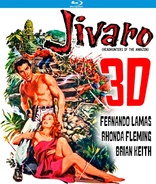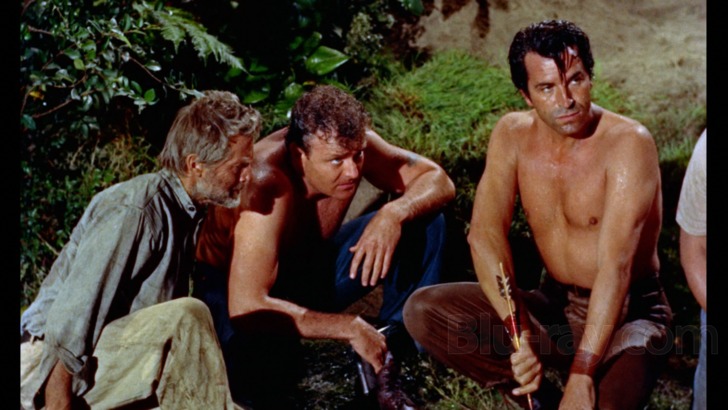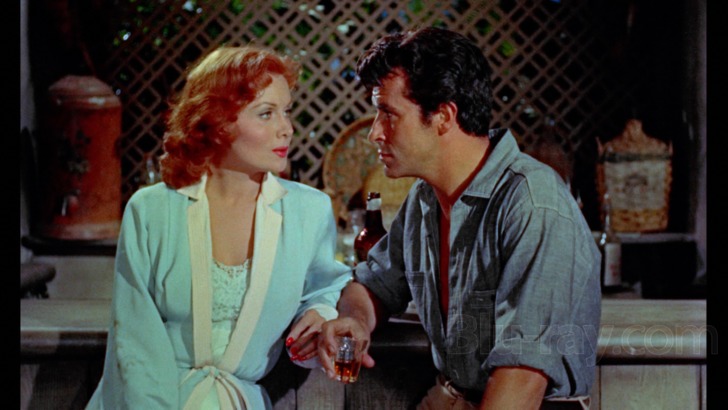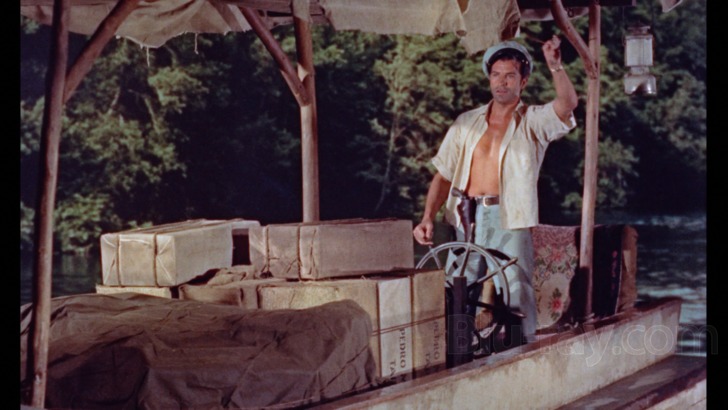Jivaro 3D Blu-ray Movie
HomeJivaro 3D Blu-ray Movie 
Lost Treasure of the Amazon / Blu-ray 3D + Blu-rayKino Lorber | 1954 | 92 min | Not rated | Mar 26, 2019

Movie rating
6.5 | / 10 |
Blu-ray rating
| Users | 4.8 | |
| Reviewer | 4.0 | |
| Overall | 4.0 |
Overview
Jivaro 3D (1954)
A gorgeous American arrives in Brazilian headhunter country, seeking her scape-grace fiancé.
Starring: Fernando Lamas, Rhonda Fleming, Brian Keith, Lon Chaney Jr., Richard DenningDirector: Edward Ludwig
| Adventure | 100% |
| Romance | Insignificant |
Specifications
Video
Video codec: MPEG-4 MVC
Video resolution: 1080p
Aspect ratio: 1.68:1
Original aspect ratio: 1.66:1
Audio
English: DTS-HD Master Audio 2.0
Subtitles
None
Discs
Blu-ray Disc
Single disc (1 BD)
Blu-ray 3D
Playback
Region A (B, C untested)
Review
Rating summary
| Movie | 3.5 | |
| Video | 4.5 | |
| Audio | 3.5 | |
| Extras | 3.0 | |
| Overall | 4.0 |
Jivaro 3D Blu-ray Movie Review
Reviewed by Martin Liebman March 5, 2019Director Edward Ludwig's Adventure film Jivaro was photographed in 3-D in 1953, supposedly "on location" in the lush and dense jungles of South America, but the production ultimately scaled back to the point that perhaps the only "authentic" location shots come in the form of stock footage inserts seen at several points throughout the film. But as any savvy moviegoer knows, it's not necessarily the where but rather the how and the why that can make a movie, and Jivaro isn't really any the worse for not trekking its cast and crew to remote corners of the globe. What the film lacks in location authenticity is more than remedied by a simple but effective plot and a spirited, bare-chested performance from its leading man, the legendary Fernando Lamas (who previously worked with Ludwig on Sangaree), who finds a rich and ripe chemistry with the lovely leading lady Rhonda Fleming (Those Redheads from Seattle). The film never did premiere in 3-D during its initial theatrical run, releasing at a time when the 3-D industry was on the decline, for a number of reasons. It was not until 2006 that the film was finally seen in 3-D, and it is for this Blu-ray release from 3-D Film Archive that the picture has been fully restored in 3-D for home consumption. As is usually the case, 3-D Film Archive's website has published an insightful, detailed, and entertaining read, with plenty of support images, written by Hillary Hess. The article covers the film and the restoration in much more detail than will be visited in this review, so be sure to check it out as a necessary companion piece to this overview.

Lamas plays Rio Galdez, a handsome boatman and barkeep who operates on a remote section of the Amazon River. He frequently trades with the indigenous peoples and usually finds himself mixed up with several locals, most of whom are searching for gold in nearby mines. It's not natural gold formations that catch the attention of a man named Jerry Russell (Richard Denning) but rather the promise of long-buried hidden treasure. Legend has it that in the “Valley of the Winds” there exists “The Tomb of Gold,” a final resting place for great riches built by the Jivaro Indians as a shrine to celebrate a victory over the Spaniards. Russell has gone seeking it, at first pleading with Rio to accompany him, which he does not. One day, his fiancé, the lovely Alice Parker (Fleming), arrives looking for him. Before long, the call of treasure beckons, and a team including Rio, Alice, and the slimy, womanizing fortune hunter Tony (Brian Keith) adventure deep into the Amazon in search of gold and find themselves pitted against both angry natives and one another.
Jivaro is a little slow afoot, taking more than hour to reach the more adventurous, albeit fairly formulaic and flat, third act, a sequence that includes collapsing bridges and fights with natives that is capped by a brawl between Rio and Tony -- their second fight of the film -- with hostile, howling winds (recall “Valley of the Winds”) furthering the perils of their scrum. Despite the promise of grand adventure, the film offers remarkably little prior and actually works better in its first two acts, anyway, as a modestly agreeable character piece. Lamas and Fleming are electric, each of them some degree of stereotype but well rounded within the film’s working parameters. It’s their burgeoning romance, not the raw jungle spectaculars, that truly come to define the movie.
“That Rio, he could fall on a rock pile and come out with a handful of diamonds!” locals say of the of Lamas’ character, the bare-chested boatman and watering hole proprietor, when he suddenly arrives in town with Alice at his side. Indeed, his Rio is suave man who carries himself with a self-assured swag and dashing good looks; it’s no wonder that Alice falls for him. He comes to her rescue on more than one occasion, including when he appears at just the right time to prevent her from being raped by the aforementioned antagonist named Tony, who had whisked her sway to a gold mine with the promise of seeing the plantation where her man is purported to be. He instead takes the opportunity to be alone with her to nefarious ends. Lamas and Fleming melt into one another, from a passionate first near-kiss to a scene in which they eat a bowlful of beans soon after meeting, cooked in Rio’s own secret sauce, that she obviously dislikes but picks at, anyway (after being served seconds after she's dumped her first round in the water when he wasn't looking), because it’s polite, it’s food, and she’s already got something of an eye for him (and, as a completely random aside, does anyone in movie history eat on-screen so passionately as Fernando Lamas?). Their intimate sparks are enough to keep the film moving and craft it into an enjoyable romance with the adventure playing out more on the side rather than as its defining, beating-heart characteristic.
Jivaro 3D Blu-ray Movie, Video Quality 

"Interaxial" is the technical term for the measured distance between the two lenses used in a 3-D production, affecting the perceived level of depth in
any given scene. Most 3-D films of the time when Jivaro was made utilized a fixed interaxial, which was generally measured at the same
average
distance between human eyes. Jivaro instead made use of a variable interaxial, adjusted on a scene-by-scene basis, which made it one of the
few to do so and rather unique for its time. A reduced interaxial, less than the norm and judiciously applied, can also make the scenes easier on the
eyes.
This unique title was also a challenging restoration for the 3-D Film Archive, which restored the film for Blu-ray 3-D from the original camera negative
for the right eye and the interpositive for the left eye, as they often had radically different timing. The resultant image is a pleasure, some of the
Archive's finest work, and certainly a lovingly
restored finished product allowing audiences to see the film as it was meant to be seen many decades ago.
The picture is hugely impressive...quite literally...from the opening titles forward. Sitting as close and as is comfortable and practical to the 3-D display
reveals the title
card and key cast names appearing to push right into the viewer's lap, while additional title credits offer solidly defined forward separation from the
background jungle footage. The first shot featuring Rio on his ship offers a well defined stretch, allowing the viewer to immediately get a feel for the
vessel's length. Rio's barroom and trading post offers a tangible sense of location intimacy. The viewer enjoys an instant feel for its volume, the density
of various furnishings, and the size of bulky support pillars inside of it. The action unfolding outside of its windows presents with a sensibly deep, but
not
focal, further stretch into town that serves to expand the depth while also curating a realistic visual tone and texture for the film (there's a good
segment in the commentary track that covers this topic in some detail during a discussion of aperture and focal length and how the film often seems to
account for extending the length of a scene through various portals and slatted windows).
Indeed, even as the movie gains a frequently appreciable sense of space in 3-D, it also gains a welcome and critical feel for viewer intimacy with the
characters. Tight character shots -- the scene in which Rio first meets Alice around the 20-minute mark -- play with a grand, big-screen feel to them,
bringing the viewer right into the heart of the conversation, right alongside the characters. In the next scene, the two are on Rio's riverboat. A few
shots put the viewer opposite the couple on the other side of the wheel; it's the next best thing to sitting in the vessel with them, and in 3-D, all that's
missing are the smells and the Amazon heat. It's another example of that "you are there" intimacy that really defines so many of the movie's best 3-D
shots, which are ample even if they are often simple static character shots that follow developing conversations.
The movie does not overindulge in gimmick shots, though some are present and executed to various levels of success. In an early scene featuring Rio
trading with natives (one of whom is played by Marvin Miller, the man who voiced "Robby the Robot" in Forbidden Planet), Rio unfurls two bolts of fabric by throwing them right
into the camera. It's not a duck-and-dodge
example of extra-screen excess but it's a fairly good effect overall. A bar fight around an hour into the movie features two of the better
outward-extending effects in the film when a bottle is thrown against the camera and a large vase is similarly tossed towards the audience a few
moments later.
Primarily, the 3-D presentation is all about drawing the viewer into the world and closer to the characters. There's plenty of shape and depth and
separation that altogether feels natural and welcoming. This is one of the finest efforts yet from the 3-D Film Archive, though at this point ranking them
is
like ranking one's children from favorite to least favorite: practically impossible and an unenviable task because they're all superb in their own
way.
The 2-D only picture, which is still available to those without access to 3-D playback screens (or who would simply choose to view the film in this way,
which is a perfectly legitimate watch to see the film as it was somewhat unceremoniously released to theaters back in 1954), delivers a very healthy
viewing experience.
Textural richness extends through the film, with every environment -- dense jungle, open waters, small boat interiors, larger shops and barrooms --
boasting carefully manicured details and excellent film-quality delivery. Light grain is retained for the duration, a positive force in defining the image's
high yield textures and holding the picture up as a steady, filmic joy. Viewers will see and appreciate an endless supply of clearly and sharply
reproduced details, with the image showcasing well beyond the front-and-center textures and displaying sweat, weathering, and various lived-in
touches that give the film a sense of vitality and place, critical in enjoying its complexities and buying its story and locations alike. Character details --
faces, clothes -- are sharp and fruitfully clear and well defined throughout. Colors are healthy and deep; the Archive's colorists have gone to
painstaking lengths to even out the inconsistent timing in the source, resulting in a genuinely striking Technicolor palette that displays everything from
lush jungle
greens to Fleming's bold red hair with impressive punch and depth. The film itself does lack in the flat constraints of the 2-D picture, but it's a very
watchable alternative as it is. All of these detail and color characteristics carry over to the 3-D image as well.
Jivaro 3D Blu-ray Movie, Audio Quality 

The included DTS-HD Master Audio 2.0 lossless soundtrack is capable of carrying the film but offers little of sonic interest beyond conveying the basics. Music is undeniably harsh at times, lacking fine-point clarity and precise definition. There's also not much sense of spread and space along the front left and right channels, favoring a somewhat cramped front-middle positioning. Nevertheless, basic definition is fine, supporting the movie in drama and adventure alike with adequate instrumental pronouncement. Ambient effects are nicely supportive, with jungle ambience filling in backgrounds and subtly carrying various scenes, notably a nighttime dialogue scene between Rio and Alice out on the river to close act one. Booming thunder and driving in rain in chapter seven additionally presents with a center-focused position. Heavy wind heard towards the end never leaves the center position, a shame considering its critical place and would-be prominence to the scene, but the narrative and visuals carry the sequence, anyway. Dialogue is clearly delivered and perfectly grounded in a front-center imaged position.
Jivaro 3D Blu-ray Movie, Special Features and Extras 

Jivaro contains a commentary, a featurette, and trailers. No DVD or digital copies are included. The release does not ship with a slipcover.
- Audio Commentary: 3-D Archive Film Historians Jack Theakston and Hillary Hess open the track, which is informative and well spoken, with emphasis on a broad range of critical and anecdotal insights alike. The participants thoroughly cover the restoration process with some accessible discussion on some of the technical details of the shoot. They also discuss actors and performances, narrative details, the film's title, the score, the budget and its impact on the production, and much more. Mike Ballew and Greg Kintz, also from the Archive, chime in partway through. Kintz offers a wonderful summation of the exhaustive restoration work at the Archive while Ballew offers a deeply technical analysis of 3-D filmmaking and the unique properties that make Jivaro stand apart from its peers. Theakston and Hess return at the 53-minute mark to close out the track with some additional scene-by-scene details: narrative, structural, and technical alike. This is a very fine track that is absolutely worth every minute spent with it.
- Jivaro: A Shot by Shot Stereosclopic Analysis (in 3-D) (1080p, 8:26): A compelling piece that deconstructs the technical details behind several scenes from the film by way of on-screen text, revealing the differences in 3-D photographic construction. Each shot is accompanied by the date the shot was filmed, the set-up number, the lens focal length, the interaxial setting, and the convergence setting. The supplement will play in 2-D but is obviously of much more value watching in 3-D.
- Trailers (1080p): Trailers for Jivaro, Cease Fire, Sangaree, Those Redheads from Seattle, and The Maze (only the latter of which appears in 3-D).
Jivaro 3D Blu-ray Movie, Overall Score and Recommendation 

It is more than a little ironic that Jivaro theatrically debuted at a time when the 3-D format was back on its heels and that it has finally released for home 3-D consumption decades later in 2019 at a time when the Blu-ray 3-D marketplace is finding it increasingly difficult to maintain its foothold. Large studio support has dwindled with only the rare, and usually converted, release still making its way into the hands of 3-D's passionate fanbase. But the good folks at the 3-D Film Archive certainly see and appreciate the artistry of Hollywood's vintage 3-D classics -- even if some were never properly exhibited in their days -- and the studio is continuing to painstakingly and lovingly restore these gems for a format that does do them justice. Jivaro is another crowning achievement, a wonderful representation of 3-D filmmaking then and the restorative process and home delivery means now. It is another must-see and must-own release from the Archive and Kino Lorber, and one of the best overall releases money can buy so far in 2019. Very highly recommended.
Similar titles
Similar titles you might also like

Those Redheads from Seattle 3D
1953

September Storm 3D
1960

Wings of the Hawk 3D
1953

Tarzan
2013

The Wild Life
2016

Sangaree 3D
1953

A Turtle's Tale: Sammy's Adventures
Sammy's Adventures: The Secret Passage / Sammy's avonturen: De geheime doorgang
2010

The Jungle Book
1994

Atlantis: Milo's Return
2003

My Little Pony: The Movie
2017

Sinbad: The Complete First Season
2012

Dragonheart 3: The Sorcerer's Curse
2015

Dragonheart: Battle for the Heartfire
Dragonheart 4
2017

The Rescuers Down Under
1990

The Rescuers
1977

Dragon's Lair II: Time Warp
1991

Ralph Breaks the Internet 4K
Ultimate Collector's Edition
2018

Dragon's Lair
1983

101 Dalmatians II: Patch's London Adventure
Special Edition
2003

Jungle Shuffle 3D
2014